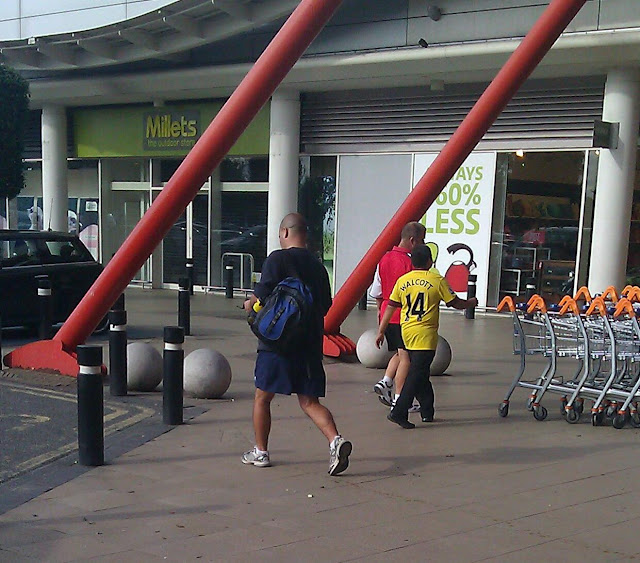Ah, an English summer! (Vitamin D?)
Giving this post another try, after wiping half of it out when I didn’t have the energy to try to fix it. Another rainy day prompted me to come back to it. 🙂
From the 16th, on Tumblr:
You may have been living in Greater London for a while when…
…you suddenly realize that it’s seeming normal to reach for a pair of jeans and a jacket to go grocery shopping in the middle of June. And, even though the temperature isn’t that low by the thermometer (15°C/59°F ATM), you know you will be very sorry if you don’t at least take the jacket along, between the humidity and the windchill on an intermittently drizzly day.
Whereas, back in Virginia about now, you would probably be wishing you could feasibly peel off your skin before going out if it might make you feel a couple of degrees cooler.
In a way, this is good, since I don’t do so well with heat anyway. But, no damned wonder a majority of the (White*) population is low on vitamin D year round.
* “The 154 non-whites of the cohort who were excluded from the study have a higher prevalence of profound vitamin D deficiency, 50% less than 10ng/ml.” Erm, yeah. And light skin doesn’t even help much if you have a burn-resistant skin type that takes at least twice the UV exposure to synthesize D even before it tans–and I really do worry now about the majority with more melanin starting out. 😐
_____________
So, once I got to thinking about it again, I paid more attention to what people were wearing, and couldn’t resist pulling out my phone and discreetly snapping some photos to illustrate. (I meant to post this that night, but I got too tired, and yesterday there was serious disruption from our boiler getting replaced. But, hot water and heat FTW!) I’m a little uncomfortable photographing strangers without permission and plastering them on Teh Interwebz, but this is more sociological than anything else. Still, I did not point my phone at people I figured already had enough problems and would not want to feel like they’re being singled out, like a group of I think Somali women with preschool girls covered up to a point that is just not a good idea practically in this climate.
Most of these were taken within a few minutes of sitting on a bench outside the supermarket at our nearest shopping centre. I also got a couple while walking down the sidewalk there, a couple at the bus stop, and one on the bus on the way home. None of them is great, since I was trying not to creep people out by obviously pointing my camera phone at them, much less suggest they stand still and say cheese. 😉

This was an unusual shot, with more than one person in shorts. But, the sun was temporarily out so it was feeling warmer, and it looked like the guy in the blue shorts was just leaving the gym in there.

This is a more representative sample.
And, no, I was not exaggerating with the “you will be very sorry…”

“if you don’t at least take the jacket along”

Some people were even opting for winter coats, like the one on the right.

I missed getting a photo of one woman in a winter coat, knitted wooly hat and scarf, and Ugg knockoffs, which struck me as a bit extreme for weather in the high 50s F. Not to mention in June. But, here’s someone in a wool beret and boots:

Another group shot with very mixed attire, though only one person in short shirtsleeves, AFAICT:

I saw several guys hedging their bets with shorts and hoodies, but only managed to get this one guy in what looks to be a lighter long-sleeved t-shirt and shorts in the background:

I was also not just being snarky about the vitamin D concerns. Even looking at the White British population, the climate means not much sunlight on one’s skin even in June. I mean, one day it’s weather for shorts and tank tops, the next week it can be like living in a dank basement-cum-wind tunnel. Also, what I see in this photo set agrees with previous observations: the vast, vast majority of people you see wearing shorts even when it’s sunny are men (I have some ideas about this :-|), and it seems much more socially acceptable for them to walk down the street shirtless than it is back home. Very sensible, actually; I just wish the legal and social situation were such that everybody could. I also used to wonder about the “women are more likely to be cold, possibly related to anemia” thing, until I moved here and saw evidence of it. I think it’s mentioned in the synopsis linked to above, with very high prevalence of poor vitamin D status among White British adults–but, women’s levels also tend to be lower. When you’re starting out with 60% low year-round, and 90% in the winter? Not good to cover up more, no.
(Note: I may be sounding like I’m conflating sex and gender a lot in this post, but that’s a side effect of looking at epidemiology and medical perceptions. I don’t even know where to start sorting this stuff out sensibly in context.)
And all that is before you even get to non-White people; in this case, I’d even make that non-Northern Europeans, since a “Mediterranean” skin type is very badly suited to this latitude and climate, as I mentioned in the Tumblr post. (After finding out more, I would be more concerned about our rather dark Italian neighbor, except he spends a lot of time outside working on cars.) I was hoping that making a concerted effort to soak up more of the available rays would be enough, but between the D synthesis and the skin tone disharmony, I am strongly considering something that still feels absurd to me: hitting a tanning bed in the middle of summer.
And, even though we live in the Whitest borough of Greater London (“95.2% White“–older, fairly prosperous, very British population overall), as you can see from the photos there are more than a few who are not. Some of that may be confirmation bias of the “there’s someone darker-skinned than I am who is bundled up” variety. And then there are the demographics of Greater London as a whole. (“According to 2007 estimates, 31.0 per cent of London’s population is from an ethnic minority (defined as non-white) and 42.3 per cent belong to groups other than white British.”–which specifically does not include “White Irish”, BTW.) So, this would seem to be a significant problem, requoting one really frightening figure: “The 154 non-whites of the cohort who were excluded from the study have a higher prevalence of profound vitamin D deficiency, 50% less than 10ng/ml.”
While it’s easy to attribute this difference to certain groups keeping more skin covered for cultural and religious reasons, I have noticed another aggravating factor which seems just as important. Thanks to the colonial history, most non-European immigrants are coming from climates a lot warmer than I am used to. And people who did not grow up in this climate are understandably prone to bundling up just because they’re cold. (It’s hard to see here, but that fellow was wearing a sweatshirt on top of a t-shirt, under the heavy sweater jacket.)

In this context, I can’t help but think of a person my mom was chatting with when she was visiting, whose mother’s feet hadn’t been warm in the 25 years since she’d moved here. And that’s coming from Cyprus, not, say, Bangladesh, Nigeria, or Jamaica. 😐 I have been doubling up on socks half the time during the winter–even around the house–coming from a colder but not nearly as unrelentingly damp and windy winter climate. I mean, I started out wondering why people were complaining about the cold when it was well above freezing (see also the rather funny West Virginia Temperature Conversion Chart), but then I moved here and saw pretty quickly.
Not too surprisingly, the resurgence of rickets (which takes a profound D deficiency) was noticed in the 1960s among the children of South Asian immigrants–and this is still a big problem. There is still an actual diagnostic category of (South) “Asian Rickets and Osteomalacia”. See also Danger of stereotyping in suspected osteomalacia, which not only means that some people are assumed to have it based on ethnicity when they really have something else serious going on–as the piece points out–but that even other immigrants who don’t fit that ethnic profile are at risk of getting their osteomalacia/rickets/other deficiency symptoms overlooked and dismissed.
Not that this can’t be a problem for people who do come closer to fitting the profile, mind you. From Musculoskeletal pain in female asylum seekers and hypovitaminosis D3 (2004):
Deficiency of vitamin D, which can lead to osteomalacia, is common in elderly patients in Western countries. However, it is still widely underdiagnosed in young immigrant women, even though the condition has been extensively reported in the immigrant Indo-Asian population in the United Kingdom since the 1960s. 1– 4 A recent study reports an average 59 months before diagnosis was established, 5 and another study found a prevalence of 78% of hypovitaminosis D 3 (compared with 58% in controls) in an Indo-Asian population attending a UK rheumatology clinic. 6 When recognised, hypovitaminosis D 3 is easily treatable. A study on osteomalacic myopathy in veiled Arabic women in Denmark found that muscle strength returned to normal (except in maximal voluntary contraction) after six months’ treatment. 7
We expected to see this disease in female asylum seekers, especially in those from societies with different customs regarding exposure to sunlight and diet. We report 11 cases of symptomatic hypovitaminosis D 3 in female asylum seekers ( table 1 ). We focus on the pathology encountered by the primary care doctors caring for these 11 patients, the length of time between the appearance of symptoms, and the establishment of the diagnosis of hypovitaminosis D 3 as well as the women’s response to treatment by the improvement of a wide range of clinical symptoms—bone pain, muscular weakness, and fatigue.
Also, from the same lead researcher, Female asylum seekers with musculoskeletal pain: the importance of diagnosis and treatment of hypovitaminosis D (from 2006, bolding added):
Thus, the disease is more prevalent than we generally suspect, not only in at-risk individuals in our multicultural societies, but probably also in a population that appears less vulnerable…
The first diagnoses, before hypovitaminosis D was considered, were chronic back pain, generally associated with pelvic or rib pain, in 17 patients (51.5%); somatisation disorder in 7 patients (21.2%); and multiple unexplained somatic symptoms in 6 patients (18.2%). Regrouping these different diagnoses, we obtain a total of 90.1% of patients with an initial diagnosis related to somatisation. In 3 patients (9.1%), the diagnosis of hypovitaminosis D was mentioned initially. The physicians treating these 3 new patients had been formerly informed of the possible high prevalence of the disease prior to the consultation and had suspected it on presentation.
The mean duration of symptoms before diagnosis was 2.53 years (SD 3.20). The duration of symptoms after seeing a physician in our centre was 1.87 years (SD 2.20). Nevertheless, in retrospect, the majority of complaints were quite typical of hypovitaminosis D from the outset.
I don’t actually remember where else I was going with this, since I managed to paste the first blockquote over half the mostly-finished post and WordPress autosaved it before I could restore from draft. And moving things from short-term to longer-term memory isn’t going so well lately.
But, I am sure I have gotten more condescending, dismissive, and infuriatingly paternalistic treatment in medical settings because I am a rather weird-acting foreigner from a very different cultural background, who is read as a woman. (I’m throwing the disability-related stuff under “weird-acting” by local standards, because AFAICT, they are mostly not differentiating even with Asperger’s on my chart.) And that is even with my probably getting read as far more straightforwardly Irish-American, no matter what I have written on their forms, based on my surname and sun-starved complexion–i.e., not the “bad” type of immigrant at all (and I do notice different treatment regularly, not ringing xenophobes’ alarms at a casual glance, oh my). How much less likely to be taken seriously are darker-skinned women with chronic pain who don’t speak English as a first language, and who are further part of a group which too frequently gets scapegoated and vilified? 😦
It is also cheaper and easier–especially under a giant HMO– to put very real patterns of symptoms off on “stress”, “of course you’re depressed, being an immigrant/asylum seeker from a horribly oppressive culture” (according to your common or garden variety xenophobe, that is), “it must be your hormones” (ironically right!), and so on–not to mention the good old “I don’t understand what’s going on, so you must be crazy and/or making it up”. Put these factors together, and you’ve got a bad situation which I have probably only gotten a small taste of–and, with medical PTSD already, I had to stop going to the doctor over anything more complicated than a sore throat or a particularly nasty allergic rash after some of the treatment I ran into.**
On a related note, it’s more than a little sobering to realize that you are better at recognizing and working with patterns than at least 90% of medical professionals. (That is being generous, since just maybe some of them were encouraged into the field by getting to hear that they’d make great diagnosticians! I was planning to go to med school, myself, with that as one factor.) Further throw various pre-/misconceptions and biases in the way of spotting the pattern(s) in front of you, and it is frankly a wonder that as many people eventually get correct diagnoses for any number of chronic conditions, as do. It also irks me that since I have had to recognize/self-diagnose multiple deficiencies on my own–including the D confirmed by a lab test–they are not “official”, and do not count in the stats.*
Another example of reliance on widgets doing real harm, when you get down to it.
ETA: There is also a rather nasty interaction between the osteomalacia and this climate, which I am rather forcefully reminded of again today. I haven’t run across any “official” mention of this, but plenty of anecdotal evidence that I’m not the Lone Ranger here: much like a lot of people’s arthritis responds to the weather, osteomalacia-affected bones and teeth will ache abominably in cool, damp weather, to the point of being able to feel the whole long bones running down your limbs. It’s like they’ve been sneakily replaced with some painful substance other than bone. Falling barometric pressure is sometimes enough, even before the temperature drops and it gets rainy. (The warmth of basking in the sun or a long, hot shower helps the pain, too. Hot drinks help the teeth, unless they’ve decided to be heat-sensitive that day!) Not to sound unrelentingly negative here, but I am just not in love with the British climate today.
_____________
* There is really no excuse for brushing people off when they come in with adult-diagnosed celiac and deficiency symptoms, FFS. Nor to get so lazy and HMO-encouraged pennywise that you don’t send them for nutrient status testing when diagnosing them with celiac in the first place. I have already put together some links about the prevalence of chronic pain from D/calcium/other deficiencies and osteomalacia (and other bone demineralization problems) in people with gluten intolerance affecting their digestive systems, but haven’t managed to wrap a coherent post around them yet. One good overview, including symptoms to watch out for: Osteomalacia in Adult Celiac Disease (though “the 10 minutes it takes to get enough vitamin D” from sun exposure is very low, even at midday at US latitudes in the summer, for people with Northern European skin types; this is the kind of estimate that gave me a seriously false sense of security). Not surprisingly, if the malabsorption has been going on unrecognized until you are an adult, this kind of active deficiency problem is pretty much a certainty. And there are so many different nutrients you can be low on.
A bit off topic, but too important not to mention while I’m thinking about it.
** ETA, because I seem to be on a rip today: This can also be dangerous when some of the things they refuse to listen to include “I cannot take Medication X because my liver tried to shut down on it before/it has caused A and B dangerous side effects before/it has made me feel generally horrible/it just did not work at all for me/I am also on Medication Z which makes that a very bad idea. No, I cannot take Medication Y instead, because it is so closely related to X as to make no difference.” I mean, you’d think the average patient would remember this stuff happening and not just make shit up, wouldn’t you? But, no, apparently the patient must be misremembering/blowing things out of proportion/unaware enough of their own body’s reactions that they can be safely dismissed. I mean, I have even tried changing the phrasing to “I have been told never to take X again because…” (so it’s not just my “craziness”/”stroppiness”, there is some phantom fellow doctor involved–and who the hell needs to be explicitly told never to take something again if they get a not just annoying but outright dangerous side effect?!), but that still seems to get taken as an Insulting Challenge to Authority.
Sure, I have run into this in the US, but all but one doctor I have seen under the NHS has behaved this way. (Ironically, the odd one out was a psychiatrist a horrible former GP referred me to, with a refreshing lack of God Complex.) It does not help that I’m coming from a whole culture full of “bad patients”, if anything even more so by common standards here; “there may be low tolerance for paternalistic or prescriptive behavior patterns”# is certainly one way of putting it. Which still gives me a dark chuckle.
Since I have no idea how to respond in a more effective way without starting yelling “Has my mouth been moving?! I don’t care if it’s first line in your formulary–and you think it’s ‘a good medication’–it doesn’t bleeding work for me! The stuff makes me sick!!!” and it going downhill from there, I’ve usually just protested politely (to no avail) then taken the prescription printout and thrown it in the trash. Which kinda means not getting effective treatment for whatever the problem is, or to put a different spin on it, being “noncompliant” (damn right 😉 ). And prescriptions are just an example here.
And what really gets me here, is that I do research enough to know that if I can’t take X I also can’t take Y, or that if I am taking Z I should not take either of the others (or drink grapefruit juice with it, or whatever). A lot of people don’t, and will go home and do/take whatever has been prescribed–and suffer from it. Throw in communication problems caused by language and cultural differences (and maybe disability, as has worked against me), and you’ve got a whole other level of mess.



Reading this, I suspect that it’s a very good thing that you guys didn’t end up moving to Dublin, as it’s *far* damper here than London, as well as being Vitamin D deficiency central. I couldn’t get over how dry it was there, while I was living there, when you would think the climate was quite similar.
I’m almost embarrassed, since that was venting on a really bad day. Luckily, things were usually looking better, even at a bit of a low point in the recovery process. 🙂
Good point, though. I was a bit surprised, years back, to see that we’re actually living in the driest part of Britain. (Essex is the absolute driest, apparently.) Even so, I would have probably gotten some surprise in Dublin. It might not have posed too much of a problem, though–and may not if we end up there at some point in the future–because there are always supplements, lightboxes, and sunbeds in the worst case. 😉 Just being aware that the difference in climate might need extra adjustments, to a greater extent than I’d started off thinking, helps a lot.
Here’s hoping that more doctors there are aware that a lack of vitamin D might be worth looking out for, even in lighter-skinned people.